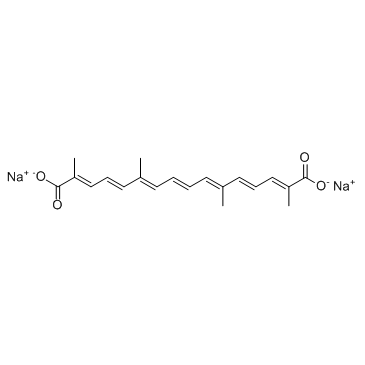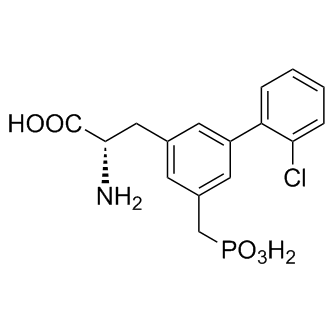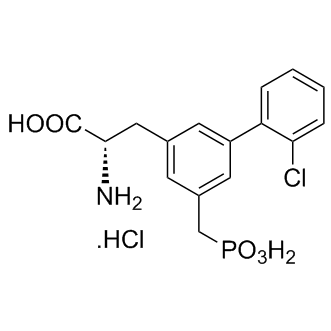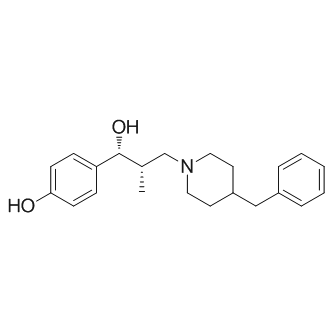 To enhance service speed and avoid tariff delays, we've opened a US warehouse. All US orders ship directly from our US facility.
To enhance service speed and avoid tariff delays, we've opened a US warehouse. All US orders ship directly from our US facility.
| Cat. No. | Product Name | Field of Application | Chemical Structure |
|---|---|---|---|
| DC45878 | NS-102 |
NS-102 is a selective kainate (GluK2) receptors antagonist. NS-102 is a potent GluR6/7 receptor antagonist.
More description
|

|
| DC10394 | Org-26576 |
Org 26576 is a AMPA receptor positive allosteric modulator.
More description
|

|
| DC45310 | UBP316 |
UBP316 (ACET) is a highly potent and selective kainate receptor GluK1 (GluR5) antagonist, with a Kb value of 1.4 nM. UBP316 is effective at blocking the depression of both field excitatory postsynaptic potentials (fEPSPs) and monosynaptically-evoked GABAergic transmission induced by ATPA, a GluK1 selective agonist.
More description
|

|
| DC44932 | UBP-282 |
UBP-282 is a potent, selective and competitive AMPA and kainate receptor antagonist. UBP-282 inhibits the fast component of the dorsal root-evoked ventral root potential (fDR-VRP) with an IC50 value of 10.3 μM. UBP-282 antagonizes kainate-induced depolarisations of dorsal roots with a pA2 value of 4.96.
More description
|

|
| DC44931 | N-Methyl-DL-aspartic acid |
N-Methyl-DL-aspartic acid is a glutamate analogue and acts as a potent neuronal excitant. N-Methyl-DL-aspartic acid is a NMDA receptor agonist and can be used for neurological diseases research.
More description
|

|
| DC44930 | (S)-(-)-HA 966 |
(S)-(-)-HA 966 ((-)-HA 966), a γ-Hydroxybutyrate-like agent, is weakly active as an NMDA-receptor antagonist. (S)-(-)-HA 966 possesses muscle relaxant action and prevents enhanced mesocorticolimbic dopamine metabolism and behavioral correlates of restraint stress, conditioned fear.
More description
|

|
| DC42516 | (R)-Lanicemine |
(R)-Lanicemine ((R)-AZD6765) is the less active R-enantiomer of Lanicemine. Lanicemine (AZD6765) is a low-trapping NMDA channel blocker (Ki of 0.56-2.1 μM for NMDA receptor; IC50s of 4-7 μM and 6.4 μM in CHO and Xenopus oocyte cells, respectively). Antidepressant effects.
More description
|

|
| DC42515 | (Rac)-Lanicemine |
(Rac)-Lanicemine ((Rac)-AZD6765) is the racemate of Lanicemine. Lanicemine (AZD6765) is a low-trapping NMDA channel blocker (Ki of 0.56-2.1 μM for NMDA receptor; IC50s of 4-7 μM and 6.4 μM in CHO and Xenopus oocyte cells, respectively). Antidepressant effects.
More description
|

|
| DC42514 | Lanicemine dihydrochloride |
Lanicemine (AZD6765) dihydrochloride is a low-trapping NMDA channel blocker (Ki of 0.56-2.1 μM for NMDA receptor; IC50s of 4-7 μM and 6.4 μM in CHO and Xenopus oocyte cells, respectively). Antidepressant effects.
More description
|

|
| DC42513 | Sepimostat dimethanesulfonate |
Sepimostat (FUT-187) dimethanesulfonate exhibits neuroprotective activity via NR2B N-methyl-D-aspartate receptor antagonism at the Ifenprodil-binding site of the NR2B subunit. Sepimostat (FUT-187) dimethanesulfonate inhibits the Ifenprodil binding with a Ki value of 27.7 µM.
More description
|

|
| DC42512 | Cycloleucine |
Cycloleucine is a specific and reversible inhibitor of nucleic acid methylations. Cycloleucine is also a competitive inhibitor of ATP: L-methionine-S-adenosyl transferase in vitro. Cycloleucine is antagonist of NMDA receptor associated glycine receptor, with a Ki of 600 μM. Cycloleucine has anxiolytic and cytostatic effects.
More description
|

|
| DC41734 | Conantokin G TFA |
Conantokin G TFA, a 17-amino-acid peptide, is a potent, selective and competitive antagonist of N-methyl-D-aspartate (NMDA) receptors. Conantokin G TFA inhibits NMDA-evoked currents in murine cortical neurons with an IC50 of 480 nM. Conantokin G TFA has neuroprotective properties.
More description
|

|
| DC41733 | Conantokin G |
Conantokin G, a 17-amino-acid peptide, is a potent, selective and competitive antagonist of N-methyl-D-aspartate (NMDA) receptors. Conantokin G inhibits NMDA-evoked currents in murine cortical neurons with an IC50 of 480 nM. Conantokin G has neuroprotective properties.
More description
|

|
| DC41137 | 1-Aminocyclobutanecarboxylic acid |
1-Aminocyclobutanecarboxylic acid is a NMDA receptor partial agonist acting at the glycine site, NR1.
More description
|

|
| DC41123 | GYKI-47261 dihydrochloride |
GYKI-47261 dihydrochloride is a competitive, orally active, and selective AMPA receptor antagonist with an IC50 of 2.5 μM. GYKI-47261 has broad spectrum anticonvulsive activity and neuroprotective effects. GYKI-47261 dihydrochloride is also a potent inducer of CYP2E1.
More description
|

|
| DC41122 | cis-ACPD |
cis-ACPD is a potent agonist of NMDA receptor, with an IC50 of 3.3 μM. cis-ACPD is also a selective agonist of group II mGluR, with EC50s of 13 μM and 50 μM for mGluR2 and mGluR4, respectively.
More description
|

|
| DC41111 | CP-465022 hydrochloride |
CP-465022 hydrochloride is a potent, and selective noncompetitive AMPA receptor antagonist with anticonvulsant activity. CP-465022 is against Kainate-induced response with an IC50?of 25 nM in rat cortical neurons. CP-465022 provides a new tool to investigate the role of AMPA receptors in physiological and pathophysiological processes.
More description
|

|
| DC40879 | Sepimostat |
Sepimostat exhibits neuroprotective activity via NR2B N-methyl-D-aspartate receptor antagonism at the Ifenprodil-binding site of the NR2B subunit. Sepimostat inhibits the Ifenprodil binding with a Ki value of 27.7?μM.
More description
|

|
| DC40353 | Quisqualic acid |
Quisqualic acid (L-Quisqualic acid), a natural analog of glutamate, is a potent and pan two subsets (iGluR and mGluR) of excitatory amino acid (EAA) agonist with an EC50 of 45 nM and a Ki of 10 nM for mGluR1R. Quisqualic acid is isolated from the fruits of Quisqualis chinensis.
More description
|

|
| DC40065 | Salfaprodil |
Salfaprodil (Neu2000 potassium) is an NR2B-selective and uncompetitive antagonist of N-methyl-D-aspartate (NMDA), and a free radical scavenger. Salfaprodil has excellent neuroprotection against NMDA- and free radical-induced cell death.
More description
|

|
| DC28118 | ATPA |
ATPA is a selective glutamate receptor GluR5 activator with EC50s of 0.66, 9.5, 1.4, 23, 32, 18, and 14 μM for GluR5wt, GluR5(S741M), GluR5(S721T), GluR5(S721T, S741M), GluR5(S741A), GluR5(S741L), and GluR5(S741V), respectively.
More description
|

|
| DC7754 | ZK-200775 |
ZK 200775 is a competitive GluR (AMPA)/kainate antagonist.
More description
|

|
| DC12170 | Transcrocetinate disodium (Disodium trans-crocetinate) |
Transcrocetinate disodium, extracted from saffron (Crocus sativus L.), acts as an NMDA receptor antagonist with high affinity.
More description
|

|
| DC8308 | SYM2206 |
SYM2206 is a novel, potent, non-competitive AMPA receptor antagonist (IC50 = 2.8 μM ).
More description
|

|
| DC7536 | YM-90K hydrochloride |
Selective AMPA receptor antagonist (Ki values are 84, 2200 and > 37000 nM For AMPA, kainate and NMDA receptors respectively). Neuroprotective.
More description
|

|
| DC9522 | SDZ 220-581 |
SDZ 220-581 is a potent, competitive antagonist at the NMDA glutamate receptor subtype(pKi= 7.7).
More description
|

|
| DC9523 | SDZ 220-581 (hydrochloride) |
SDZ 220-581 Hcl is a potent, competitive antagonist at the NMDA glutamate receptor subtype(pKi= 7.7).
More description
|

|
| DC11176 | S44819 |
S44819 (S 44819, Egis-13529) is a novel potent, competitive, selective antagonist of the α5-GABAAR with Kd of 221 nM, IC50 of 585 nM (α5β2γ2).
More description
|

|
| DC9851 | Ro 25-6981 |
Ro 25-6981 is a potent and selective activity-dependent blocker of NMDA receptors containing the NR2B subunit.
More description
|

|
| DC11188 | PF-4778574 |
PF-4778574 (PF4778574) is a brain penetrant, positive allosteric modulator (potentiator) of AMPA receptor with Ki of 85 nM, increases S-AMPA-evoked responses in rat primary cortical neurons with EC50 of 45-919 nM.
More description
|

|